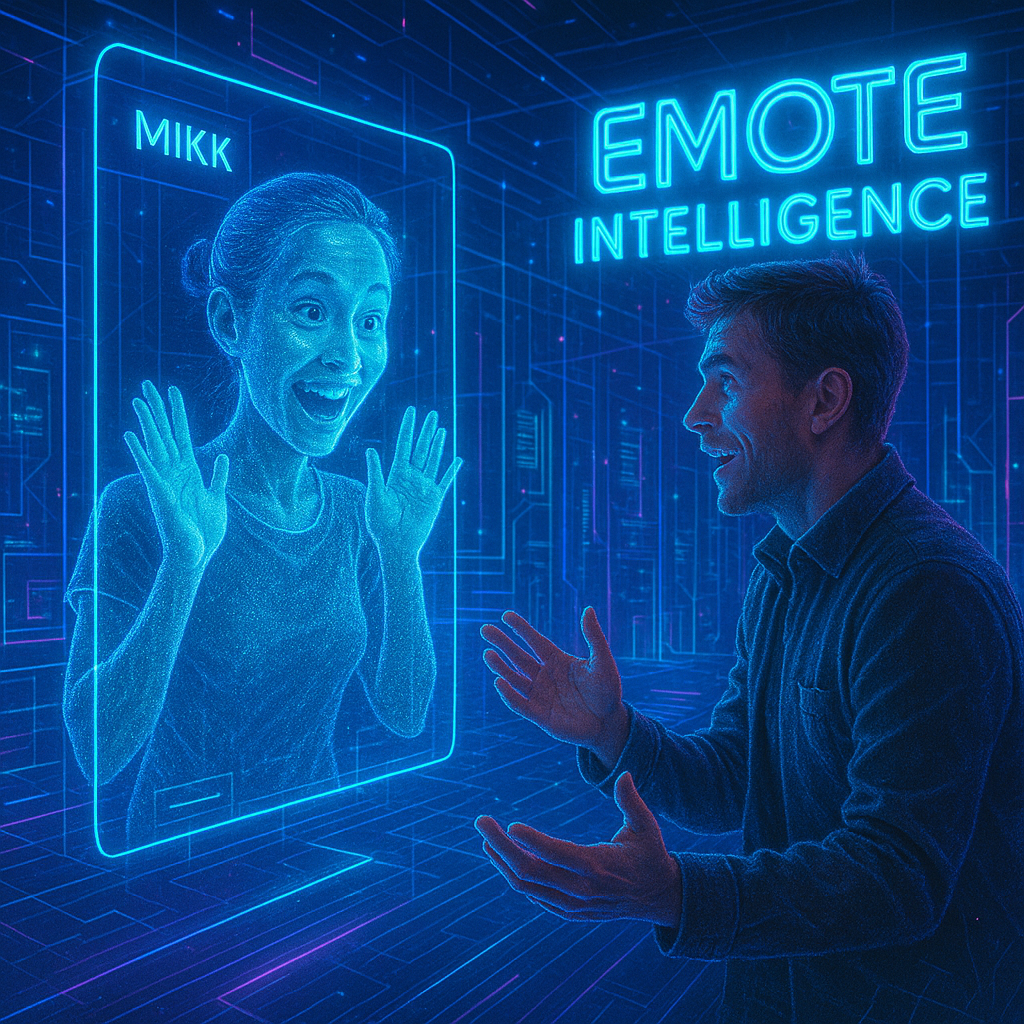
Introduction: The Rise of Emotionally Aware Machines
We’ve trained machines to think, speak, and even create — but what about feel? The new evolution in artificial intelligence isn’t just about intelligence or speed; it’s about empathy. Welcome to the world of Emote Intelligence, a domain where AI can interpret, respond, and adapt to human emotions in real time.
While much of the world is still exploring the idea, India — with its culturally rich emotional expressions — is quietly building a powerful ecosystem of emote-aware technologies. One standout innovator is MiKK, which is redefining how we experience emotion in digital conversations through intelligent avatars.
What is Emote Intelligence?
Emote Intelligence refers to a class of AI systems designed to understand and respond to human emotions with context, empathy, and adaptability. It’s a progression from Emotional AI — which only detects emotions — to AI that interacts emotionally and learns from user sentiment.
At its core, Emote Intelligence blends multiple technologies:
- Affective computing
- Deep NLP with emotional sentiment layers
- Reinforcement learning based on mood patterns
- Real-time behavioral adaptation
🧠 Example:
If a user is feeling anxious, an emotionally intelligent AI doesn’t just detect the sentiment — it adjusts tone, pacing, and even visual expression (like MiKK’s avatars) to offer comfort, suggestions, or simply listen.
How Emote Intelligence is Different from Emotional AI
While the terms are often used interchangeably, the distinction is important:
| Criteria | Emotional AI | Emote Intelligence |
|---|---|---|
| Emotion Recognition | ✅ | ✅ |
| Real-time Emotional Adaptation | ❌ | ✅ |
| Empathy Simulation | ❌ | ✅ |
| Learning Over Time | ⚠️ (limited) | ✅ (contextual learning) |
| Human-like Interactions | ❌ | ✅ |
In short, Emotional AI = detection, while Emote Intelligence = dynamic emotional interaction.
The Science Behind Emote Intelligence
Unlike basic sentiment analysis, Emote Intelligence uses a multi-layered cognitive-emotional model that includes:
1. Affective Loop Systems
AI creates a feedback loop where it learns how users react emotionally to its responses, creating more human-like interactions over time.
2. Emotional Vector Mapping
AI assigns emotional weightage to words, pauses, gestures (via camera input), and even emojis — generating an emotional map for each interaction.
3. Contextual Empathy Layers
Some Indian startups like MiKK are building NLP engines that can understand not just words but how they are said — detecting sarcasm, melancholy, or joy — and altering responses accordingly.
4. Memory-Driven Sentiment Threads
Imagine a system that remembers if you’ve been feeling low for a week and modifies its tone across all chats — that’s Emote Intelligence.
MiKK: India’s Avatar-Based Emote Intelligence Pioneer
Among India’s most innovative emotional tech players, MiKK stands out by combining emote intelligence with avatar communication. It’s not just chat — it’s emotion-driven visual interaction.
MiKK’s unique features:
- Smart avatars that display real-time emotions based on user mood
- Emotion learning: MiKK learns how you react, what calms or excites you
- Empathic conversation flows: Responses change in tone and structure depending on emotional context
For Gen Z — a generation that thrives on visual emotion (emojis, reels, memes) — MiKK’s emotionally intelligent avatars provide a native form of digital communication.
Why India is Poised to Lead the Emote Intelligence Wave
1. Cultural Depth in Emotional Expression
India’s linguistic and cultural diversity offers a wide emotional spectrum — from subtle cues in Hindi to expressive gestures in Tamil. Emote Intelligence in India is being trained on rich datasets that global systems simply don’t have.
2. Mental Health Integration
Platforms using emote intelligence can help address India’s mental health crisis, especially where counselors aren’t accessible. AI companions that feel and respond like a human can be a game-changer.
3. Education & EdTech Revolution
Imagine emotionally-aware tutors that adjust difficulty, tone, and encouragement based on student mood. This isn’t sci-fi — Indian edtechs are already exploring this.
4. Emotion-Sensitive Customer Service
Companies are increasingly turning to AI agents. With emote intelligence, these agents won’t just solve queries — they’ll calm angry customers, motivate confused users, and reassure the anxious.
Hidden Challenges of Emote Intelligence
While promising, Emote Intelligence brings its own set of concerns:
- Emotional Manipulation: If an AI knows how to make you feel a certain way, where do we draw the ethical line?
- Emotion Fatigue: Users may over-rely on emotionally sensitive AI and lose the habit of human connection.
- Data Sensitivity: Emotion is personal. Who owns your emotional data?
MiKK, for instance, ensures encrypted emotional sessions and allows users to reset emotional data — prioritizing digital well-being.
The Future of Emote Intelligence: What Lies Ahead
As AI becomes embedded in everything — phones, homes, wearables — emotional context will become the norm. Platforms like MiKK are early proof that emotional intelligence isn’t just for humans anymore.
We are moving towards:
- Emotion-sensitive wearables (mood-based notifications)
- Emotionally reactive games
- Emotionally adaptive social media algorithms
- Empathic digital companions (elderly care, mental health)
Conclusion: The Emotional Singularity Is Near
Emote Intelligence is not about replacing human emotion, but about enhancing human-machine empathy. In India, with pioneers like MiKK, we are building not just smarter machines — but kinder, more emotionally aware ones.
As we navigate this emotional revolution, one thing is clear — the future of AI will be felt, not just calculated.


